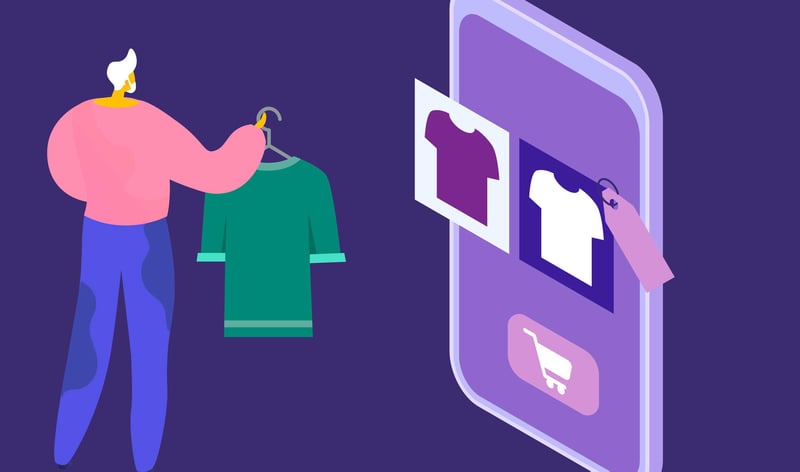During the global pandemic that had us under lockdown for most of 2020, many resellers turned to online sourcing for the very first time. Buying inventory online can be fun and rewarding, but it can also be a bit overwhelming at first. In this article, you will learn the critical differences between retail and wholesale purchases, as well as a few tips and tricks to make sure you get off to a profitable start.
Why Source Online?
Even when the world isn’t under strict stay-at-home orders, there are many advantages to sourcing online. It’s true that many resellers find a majority of their inventory thrifting, consignment shopping, or going to yard sales. However, where you live can have a huge impact on what you’re able to find at these sources. You can side-step that obstacle by buying inventory online.
When you source online, you will typically be purchasing more inventory at once, which reduces your overall cost of goods. It can be a great time saver for sellers that no longer have the time or option to spend hours per day hunting for deals at the local thrift stores, no matter how much fun it is.
You may gain access to brands you aren’t able to find when shopping locally and can choose to have more NWT (new with tags) items in your online store. You can even source boutique items that are unique to give your inventory an edge on the competition.
Finally, online sourcing using warehouse and liquidation companies can help you scale your business. You’ll be able to buy in larger quantities and grow your inventory quickly.
What Are The Options For Sourcing Online?
You can choose to buy from retail stores online, using coupons and sales to get the lowest prices possible on the exact inventory you want. Many stores have their outlet deals online, such as Nordstrom Rack who even has an app you can download. If you want the most control over the inventory you select, then retail sales are your best bet.
Are you up for a bit of a gamble? If you want to buy larger quantities of inventory for a lower rate, try sourcing from wholesale dealers. Wholesalers are like the middlemen between manufacturers and retail stores. If you buy from them directly, you can get brand new items in bulk for a much lower cost. You can also shop for boutique brands using wholesale websites like Wholesale Fashion Square or CC Wholesale Clothing.
Are you looking for second-hand fashion to source online? You can buy inventory from places like Goodwill, ThredUp, and Swap.com. You can source by the piece or grab a mystery box.
Some wholesalers require you to have a state resale certificate to purchase with them, while others do not. For example, you can get boxes or pallets of wholesale NWT or Pre-owned clothing from Jomar without a resale certificate or business license. When you buy from warehouse wholesalers like Jomar, you typically purchase inventory you can’t see beforehand. You will get brand names and a few other details, but you won’t know the exact items coming with your order.
Finally, you can scale your business quickly by buying cases and pallets of clothing, home goods, and electronics from liquidators. Liquidators help retail stores cash in on their unsold inventory. You can bid on pallets and cases of items at Liquidation.com or Bulq. Pallets can be very expensive, totaling anywhere from one to a few thousand dollars, but their cost per item is relatively low once you do the math.
You might also like: 9 Steps to Start a Reselling Business Online for Profit
Are There Any Drawbacks To Online Sourcing?
Buying inventory from the comfort of your own home is convenient and, in some cases, very rewarding. But if you are used to having total control over each piece of inventory you select, then you might need to adjust your expectations a bit. Sourcing from warehouses and liquidators means giving up a little of that control in exchange for a lower cost of goods.
There is inherently more risk when shopping wholesale or liquidation online.
When you source new or pre-owned inventory online, you lose the ability to hold each piece in your hand and decided if you want it or check it for flaws. Warehouse and liquidation inventory usually comes with an acceptable flaw rate and can have stains, rips, or other damage on some of the pieces. When you accept a mixed lot, you also don’t usually get to see what exact sizes and styles you’re going to get. It’s not all bad news; unboxing your mixed lots can be just as exciting as hunting for bargains at the bins. Also, you can control your cost of goods by being selective with which companies you buy from and in what quantities.
It costs more upfront.
You can pop into the thrift store and spend a quick $20 on a few items. However, sourcing online means spending more of your sourcing budget at a time. You can buy inventory by the pack (10-20 items), by the box (20-50 items), or by the pallet to get 100s of items at once. Depending on the brands and conditions, you can expect to pay anywhere from $60 to $250 per box and $1,000+ on pallets. (Don’t forget, shipping costs on boxes and pallets can be pretty high as well, so factor that into your cost of goods.)
You need to have extra space and the capacity to process larger amounts of inventory at a time.
If you are a slow lister, it’s time to develop a system before you start sourcing online. You’ll be getting more inventory in at once, and you’ll need space to store and sort it and the time or help needed to process it all. Luckily you can save a ton of time crosslisting each item to multiple platforms using Vendoo.
5 Pro-Tips For Sourcing Online Successfully
If you feel like you’re ready to take the plunge into online sourcing, here are a few extra tips that could save you time and money. Make sure you have all the information you need to make informed decisions that impact your business before trying something new.
#1. Research, Research, Research
Make sure to read all the terms and conditions of the website and the full description of the box or pallet you are about to purchase. You can also read customer reviews and watch YouTube videos to get an idea of the quality of merchandise you can expect.
#2. Start Small And Take It Step By Step
If you’ve never sourced online before, don’t just right to a pallet which can be hundreds or even thousands of pieces of inventory. You can start with packs or boxes and then try a half pallet as you gradually grow your business.
#3. Have A Plan For Processing And Storing Inventory
Make sure you have room for your inventory to be delivered and stored while you sort through it and get ready to list it all. Have a plan to batch process your inventory, photograph it, list it, and store it efficiently.
#4. Use Codes and Sales To Save More Money
Check with your reseller friends to see if they have an affiliate code before trying a new sourcing site. Many can save you between 10-20%, which can often cover the cost of shipping. Buying items out of season can also help you save money as these items are usually on clearance.
#5. Don’t Forget To Include Shipping In Your Cost Of Goods
Shipping on boxes can be $20-$40, and pallets can be several hundred dollars for shipping and delivery. It’s easy to get mesmerized by a great deal only to discover after shipping, the cost of goods is a few dollars more than you expected. Keep the shipping cost in mind before you pull the trigger on any large purchase.
Good luck sourcing online! Do you have an online source you love to shop from? Drop it in the comments below and help a fellow reseller out!






